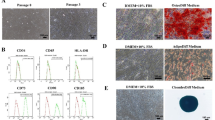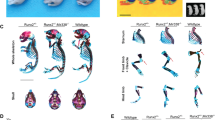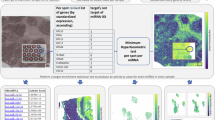Abstract
In spite of the extensive potential of human mesenchymal stem cells (hMSCs) in cell therapy, little is known about the molecular mechanisms that regulate their therapeutic properties. We aimed to identify microRNAs (miRNAs) involved in controlling the transition between the resting and reparative phenotypes of hMSCs, hypothesizing that these miRNAs must be present in the undifferentiated cells and downregulated to allow initiation of distinct activation/differentiation programs. Differential miRNA expression analyses revealed that miR-335 is significantly downregulated upon hMSC differentiation. In addition, hMSCs derived from a variety of tissues express miR-335 at a higher level than human skin fibroblasts, and overexpression of miR-335 in hMSCs inhibited their proliferation and migration, as well as their osteogenic and adipogenic potential. Expression of miR-335 in hMSCs was upregulated by the canonical Wnt signaling pathway, a positive regulator of MSC self-renewal, and downregulated by interferon-γ (IFN-γ), a pro-inflammatory cytokine that has an important role in activating the immunomodulatory properties of hMSCs. Differential gene expression analyses, in combination with computational searches, defined a cluster of 62 putative target genes for miR-335 in hMSCs. Western blot and 3′UTR reporter assays confirmed RUNX2 as a direct target of miR-335 in hMSCs. These results strongly suggest that miR-335 downregulation is critical for the acquisition of reparative MSC phenotypes.
Similar content being viewed by others
Log in or create a free account to read this content
Gain free access to this article, as well as selected content from this journal and more on nature.com
or
Accession codes
Abbreviations
- hMSC:
-
human mesenchymal stem cells
- fdr:
-
false discovery rate
References
Bernardo ME, Locatelli F, Fibbe WE . Mesenchymal stromal cells. Ann N Y Acad Sci 2009; 1176: 101–117.
Berezikov E, Guryev V, van de Belt J, Wienholds E, Plasterk RH, Cuppen E . Phylogenetic shadowing and computational identification of human microRNA genes. Cell 2005; 120: 21–24.
Hwang HW, Wentzel EA, Mendell JT . A hexanucleotide element directs microRNA nuclear import. Science 2007; 315: 97–100.
Valadi H, Ekstrom K, Bossios A, Sjostrand M, Lee JJ, Lotvall JO . Exosome-mediated transfer of mRNAs and microRNAs is a novel mechanism of genetic exchange between cells. Nat Cell Biol 2007; 9: 654–659.
Kanellopoulou C, Muljo SA, Kung AL, Ganesan S, Drapkin R, Jenuwein T et al. Dicer-deficient mouse embryonic stem cells are defective in differentiation and centromeric silencing. Genes Dev 2005; 19: 489–501.
Wang Y, Medvid R, Melton C, Jaenisch R, Blelloch R . DGCR8 is essential for microRNA biogenesis and silencing of embryonic stem cell self-renewal. Nat Genet 2007; 39: 380–385.
Suh MR, Lee Y, Kim JY, Kim SK, Moon SH, Lee JY et al. Human embryonic stem cells express a unique set of microRNAs. Dev Biol 2004; 270: 488–498.
Tay Y, Zhang J, Thomson AM, Lim B, Rigoutsos I . MicroRNAs to Nanog, Oct4 and Sox2 coding regions modulate embryonic stem cell differentiation. Nature 2008; 455: 1124–1128.
Mizuno Y, Yagi K, Tokuzawa Y, Kanesaki-Yatsuka Y, Suda T, Katagiri T et al. miR-125b inhibits osteoblastic differentiation by down-regulation of cell proliferation. Biochem Biophys Res Commun 2008; 368: 267–272.
Luzi E, Marini F, Sala SC, Tognarini I, Galli G, Brandi ML . Osteogenic differentiation of human adipose tissue-derived stem cells is modulated by the miR-26a targeting of the SMAD1 transcription factor. J Bone Miner Res 2008; 23: 287–295.
Kim YJ, Bae SW, Yu SS, Bae YC, Jung JS . miR-196a regulates proliferation and osteogenic differentiation in mesenchymal stem cells derived from human adipose tissue. J Bone Miner Res 2009; 24: 816–825.
Huang J, Zhao L, Xing L, Chen D . MicroRNA-204 regulates Runx2 protein expression and mesenchymal progenitor cell differentiation. Stem Cells 2010; 28: 357–364.
Schoolmeesters A, Eklund T, Leake D, Vermeulen A, Smith Q, Force Aldred S et al. Functional profiling reveals critical role for miRNA in differentiation of human mesenchymal stem cells. PLoS One 2009; 4: e5605.
Bae S, Ahn JH, Park CW, Son HK, Kim KS, Lim NK et al. Gene and microRNA expression signatures of human mesenchymal stromal cells in comparison to fibroblasts. Cell Tissue Res 2009; 335: 565–573.
Lopez-Romero P, Gonzalez MA, Callejas S, Dopazo A, Irizarry RA . Processing of Agilent microRNA array data. BMC Res Notes 2010; 3: 18.
Kobayashi S, Kohda T, Miyoshi N, Kuroiwa Y, Aisaka K, Tsutsumi O et al. Human PEG1/MEST, an imprinted gene on chromosome 7. Hum Mol Genet 1997; 6: 781–786.
Boland GM, Perkins G, Hall DJ, Tuan RS . Wnt 3a promotes proliferation and suppresses osteogenic differentiation of adult human mesenchymal stem cells. J Cell Biochem 2004; 93: 1210–1230.
Krampera M, Cosmi L, Angeli R, Pasini A, Liotta F, Andreini A et al. Role for interferon-gamma in the immunomodulatory activity of human bone marrow mesenchymal stem cells. Stem Cells 2006; 24: 386–398.
Duque G, Huang DC, Macoritto M, Rivas D, Yang XF, Ste-Marie LG et al. Autocrine regulation of interferon gamma in mesenchymal stem cells plays a role in early osteoblastogenesis. Stem Cells 2009; 27: 550–558.
Enright AJ, John B, Gaul U, Tuschl T, Sander C, Marks DS . MicroRNA targets in Drosophila. Genome Biol 2003; 5: R1.
Lewis BP, Burge CB, Bartel DP . Conserved seed pairing, often flanked by adenosines, indicates that thousands of human genes are microRNA targets. Cell 2005; 120: 15–20.
Krek A, Grun D, Poy MN, Wolf R, Rosenberg L, Epstein EJ et al. Combinatorial microRNA target predictions. Nat Genet 2005; 37: 495–500.
Sood P, Krek A, Zavolan M, Macino G, Rajewsky N . Cell-type-specific signatures of microRNAs on target mRNA expression. Proc Natl Acad Sci USA 2006; 103: 2746–2751.
Tavazoie SF, Alarcon C, Oskarsson T, Padua D, Wang Q, Bos PD et al. Endogenous human microRNAs that suppress breast cancer metastasis. Nature 2008; 451: 147–152.
Andl T, Murchison EP, Liu F, Zhang Y, Yunta-Gonzalez M, Tobias JW et al. The miRNA-processing enzyme dicer is essential for the morphogenesis and maintenance of hair follicles. Curr Biol 2006; 16: 1041–1049.
Sorrentino A, Liu CG, Addario A, Peschle C, Scambia G, Ferlini C . Role of microRNAs in drug-resistant ovarian cancer cells. Gynecol Oncol 2008; 111: 478–486.
Dunn W, DuRaine G, Reddi AH . Profiling microRNA expression in bovine articular cartilage and implications for mechanotransduction. Arthritis Rheum 2009; 60: 2333–2339.
Sathyan P, Golden HB, Miranda RC . Competing interactions between micro-RNAs determine neural progenitor survival and proliferation after ethanol exposure: evidence from an ex vivo model of the fetal cerebral cortical neuroepithelium. J Neurosci 2007; 27: 8546–8557.
Ronchetti D, Lionetti M, Mosca L, Agnelli L, Andronache A, Fabris S et al. An integrative genomic approach reveals coordinated expression of intronic miR-335, miR-342, and miR-561 with deregulated host genes in multiple myeloma. BMC Med Genomics 2008; 1: 37.
Greco SJ, Rameshwar P . MicroRNAs regulate synthesis of the neurotransmitter substance P in human mesenchymal stem cell-derived neuronal cells. Proc Natl Acad Sci USA 2007; 104: 15484–15489.
Nakanishi N, Nakagawa Y, Tokushige N, Aoki N, Matsuzaka T, Ishii K et al. The up-regulation of microRNA-335 is associated with lipid metabolism in liver and white adipose tissue of genetically obese mice. Biochem Biophys Res Commun 2009; 385: 492–496.
Williams AE, Moschos SA, Perry MM, Barnes PJ, Lindsay MA . Maternally imprinted microRNAs are differentially expressed during mouse and human lung development. Dev Dyn 2007; 236: 572–580.
Scarola M, Schoeftner S, Schneider C, Benetti R . miR-335 directly targets Rb1 (pRb/p105) in a proximal connection to p53-dependent stress response. Cancer Res Sep 1; 70: 6925–6933.
Ge W, He F, Kim KJ, Blanchi B, Coskun V, Nguyen L et al. Coupling of cell migration with neurogenesis by proneural bHLH factors. Proc Natl Acad Sci USA 2006; 103: 1319–1324.
Neth P, Ciccarella M, Egea V, Hoelters J, Jochum M, Ries C . Wnt signaling regulates the invasion capacity of human mesenchymal stem cells. Stem Cells 2006; 24: 1892–1903.
Karow M, Popp T, Egea V, Ries C, Jochum M, Neth P . Wnt signalling in mouse mesenchymal stem cells: impact on proliferation, invasion and MMP expression. J Cell Mol Med 2009; 13 (8B): 2506–2520.
Fillmore RA, Mitra A, Xi Y, Ju J, Scammell J, Shevde LA et al. Nmi (N-Myc interactor) inhibits Wnt/beta-catenin signaling and retards tumor growth. Int J Cancer 2009; 125: 556–564.
de la Fuente R, Abad JL, Garcia-Castro J, Fernandez-Miguel G, Petriz J, Rubio D et al. Dedifferentiated adult articular chondrocytes: a population of human multipotent primitive cells. Exp Cell Res 2004; 297: 313–328.
Zufferey R, Dull T, Mandel RJ, Bukovsky A, Quiroz D, Naldini L et al. Self-inactivating lentivirus vector for safe and efficient in vivo gene delivery. J Virol 1998; 72: 9873–9880.
Ovcharenko I, Loots GG, Giardine BM, Hou M, Ma J, Hardison RC et al. Mulan: multiple-sequence local alignment and visualization for studying function and evolution. Genome Res 2005; 15: 184–194.
Acknowledgements
We thank S Calleja and R Alvarez (CNIC) for technical help with microarrays and real-time RT-PCR; P Fernández and JC Ramírez (CNIC) for lentivirus production; F Cabo (CNIC) for bioinformatics and statistical support; C Carreiro and A Esteban (CNIC) for preparation and maintenance of plasmid stocks; M García-Arranz (Hospital Univesitario La Paz, Madrid, Spain), C Trigueros, A Izeta and A García (F Inbiomed, San Sebastián, Spain) for biological samples; S Bartlett (CNIC) for English revision and M Ramón for secretarial support. This work was supported by grants to AB from the Spanish Plan Nacional de Salud y Farmacia/CICYT (SAF 2008-02099), Comunidad Autónoma de Madrid (P-BIO-0306-2006) and Red de Terapia Celular del Instituto de Salud Carlos III (TerCel); MAG is supported by the ‘Miguel Servet’ Program (CP07/00306) of the Instituto de Salud Carlos III (Ministerio de Ciencia e Innovación, Spain); JCS is supported by the ACI-PLAN-E Program (Ministerio de Ciencia e Innovación, Spain). The CNIC is supported by the Spanish Ministry of Science and Innovation and the Pro-CNIC Foundation.
Author information
Authors and Affiliations
Corresponding authors
Ethics declarations
Competing interests
The authors declare no conflict of interest.
Additional information
Edited by JP Medema
Supplementary Information accompanies the paper on Cell Death and Differentiation website
Supplementary information
Rights and permissions
About this article
Cite this article
Tomé, M., López-Romero, P., Albo, C. et al. miR-335 orchestrates cell proliferation, migration and differentiation in human mesenchymal stem cells. Cell Death Differ 18, 985–995 (2011). https://doi.org/10.1038/cdd.2010.167
Received:
Revised:
Accepted:
Published:
Issue date:
DOI: https://doi.org/10.1038/cdd.2010.167
Keywords
This article is cited by
-
Knockdown of long noncoding RNA SAN rejuvenates aged adipose-derived stem cells via miR-143-3p/ADD3 axis
Stem Cell Research & Therapy (2023)
-
MicroRNAs-mediated regulation pathways in rheumatic diseases
Inflammopharmacology (2023)
-
MicroRNAs Function in Dental Stem Cells as a Promising Biomarker and Therapeutic Target for Dental Diseases
Molecular Diagnosis & Therapy (2023)
-
lncRNAs MALAT1 and LINC00657 upstream to miR-214-3p/BMP2 regulate osteogenic differentiation of human mesenchymal stem cells
Molecular Biology Reports (2022)
-
Transcriptional factor FoxM1-activated microRNA-335-3p maintains the self-renewal of neural stem cells by inhibiting p53 signaling pathway via Fmr1
Stem Cell Research & Therapy (2021)



